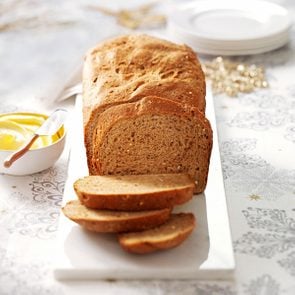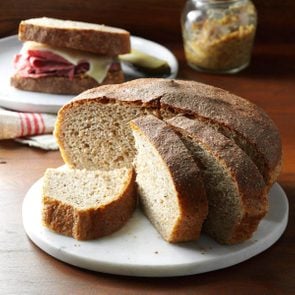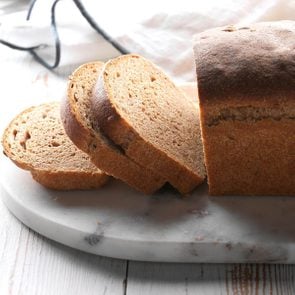The Best High-Fiber Bread Recipe (Plus, Ways to Get More Fiber Into Your Baking)
Updated: May 30, 2020

Learn how to make our easy high-fiber bread recipe, plus learn how to pack more fiber into your favorite loaf.
Baking bread is not only is supremely satisfying (who doesn’t love the smell of a fresh loaf baking in the oven?) but it also allows you to customize the bread to your liking and needs. Bakers, don’t miss our best homemade bread recipes. Many people making bread at home are looking to make a healthier loaf free of preservatives and filled with good stuff, like fiber.
How to Make High-Fiber Bread
This brown bread recipe was submitted by Kellie Foglio from Salem, Wisconsin. It packs a whopping 4g of fiber per slice due to fiber-rich ingredients like wheat bran, whole wheat four and old-fashioned oats.
Ingredients
- 2 packages (1/4 ounce each ) active dry yeast
- 3 tablespoons molasses
- 2 teaspoons agave nectar or honey
- 2-2/3 cups warm water (110° to 115°)
- 1/2 cup dried cranberries
- 2 tablespoons wheat bran
- 1 teaspoon salt
- 6 to 7 cups whole wheat flour
TOPPING:
- 1 tablespoon 2% milk
- 1 tablespoon old-fashioned oats
Directions
- In a small bowl, dissolve yeast, molasses and agave nectar in 2/3 cup warm water. In a large bowl, combine cranberries, wheat bran, salt, yeast mixture, 4 cups flour and remaining water; beat on medium speed 3 minutes until smooth.
- Stir in enough remaining flour to form a soft dough (dough will be sticky).
- Turn dough onto a floured surface; knead until smooth and elastic, 6-8 minutes. Place in a greased bowl, turning once to grease the top. Cover and let rise in a warm place until doubled, about 1 hour.
- Turn onto a lightly floured surface; divide in half. Shape into loaves. Place in two greased 8×4-in. loaf pans. Cover; let rise in a warm place until almost doubled, about 1 hour. Preheat oven to 400°.
- Brush tops with milk. Sprinkle with oats. Bake until golden brown, 30-40 minutes. Remove from pans to wire racks; cool completely.
Nutrition Facts
1 slice: 125 calories, 1g fat (0 saturated fat), 0 cholesterol, 101mg sodium, 27g carbohydrate (5g sugars, 4g fiber), 4g protein.
While not every homemade bread recipe is packed with fiber, you can make some substitutions to add more of it into your bake
Flours That Add Fiber
You can turn a basic bread recipe into a high fiber bread recipe by changing up the flours you use.
- Regular white flour has about three grams of fiber per cup.
- Whole wheat flour has 15 grams per cup.
You can trade out all or some of the all-purpose flour in your recipe for whole wheat to easily boost the fiber content.
Also, consider adding alternative flours like spelt or quinoa flour. These flours, available in health food stores or larger groceries, usually include recipes or suggestions on the packaging for their use.
Be aware that these higher-fiber flours do not form gluten as all-purpose or bread flour does. The result is a denser loaf that does not rise as high.
Pro tip: A product called vital gluten, found near specialty flours on grocery shelves that can help your load rise. Two tablespoons added to a three-cup flour loaf will enhance the rise and texture of the bread.
These specialty flours may also alter the water-binding capacity of your dough. Check your dough after five minutes of mixing; add one to two tablespoons of water or flour if needed.
Another option is to add wheat bran to your recipe. Wheat bran is 100% wheat; a quarter cup will add seven grams of fiber to your loaf. Wheat bran should be included with the flour as you assemble your dough. Try it out with this recipe for Tender Whole Wheat Rolls.
Other High-Fiber Ingredients
You don’t need to limit your thinking to just the flour you use, though. Peggy Woodward, Taste of Home‘s Registered Dietitian recommends adding seeds to your favorite bread recipe. Two tablespoons of sesame, poppy, caraway or sunflower seeds will add one to two more grams of fiber per serving. For the most fiber, try flaxseeds which add six grams of fiber.
The best time to add these seeds is during the kneading process to integrate them well into the dough. Learn how to knead bread dough the right way here. You can also sprinkle a few additional seeds on top of the loaf before baking.
The bread will bake up just the same with the addition of these seeds but you get the added benefit of more fiber and some great texture. If you want more healthy alternatives, ezekiel bread is about to become one of your newest go-to breads.






















